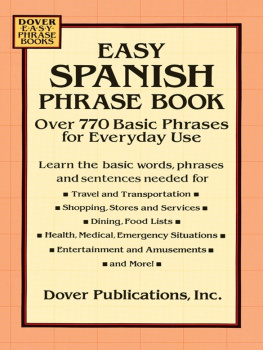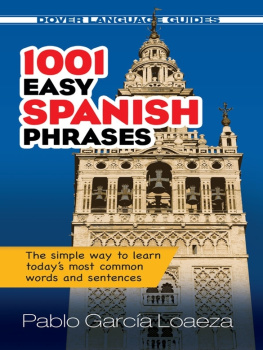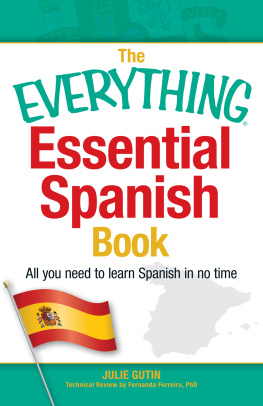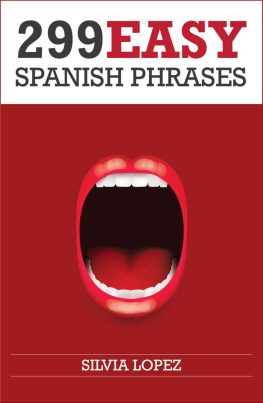Mateo Ramirez - Easy Spanish Phrase Book for Travelers: Learn How to Speak Over 1400 Unique Spanish Words and Phrases While Traveling Spain and South America
Here you can read online Mateo Ramirez - Easy Spanish Phrase Book for Travelers: Learn How to Speak Over 1400 Unique Spanish Words and Phrases While Traveling Spain and South America full text of the book (entire story) in english for free. Download pdf and epub, get meaning, cover and reviews about this ebook. year: 2019, publisher: Mateo Ramirez, genre: Detective and thriller. Description of the work, (preface) as well as reviews are available. Best literature library LitArk.com created for fans of good reading and offers a wide selection of genres:
Romance novel
Science fiction
Adventure
Detective
Science
History
Home and family
Prose
Art
Politics
Computer
Non-fiction
Religion
Business
Children
Humor
Choose a favorite category and find really read worthwhile books. Enjoy immersion in the world of imagination, feel the emotions of the characters or learn something new for yourself, make an fascinating discovery.
- Book:Easy Spanish Phrase Book for Travelers: Learn How to Speak Over 1400 Unique Spanish Words and Phrases While Traveling Spain and South America
- Author:
- Publisher:Mateo Ramirez
- Genre:
- Year:2019
- Rating:5 / 5
- Favourites:Add to favourites
- Your mark:
Easy Spanish Phrase Book for Travelers: Learn How to Speak Over 1400 Unique Spanish Words and Phrases While Traveling Spain and South America: summary, description and annotation
We offer to read an annotation, description, summary or preface (depends on what the author of the book "Easy Spanish Phrase Book for Travelers: Learn How to Speak Over 1400 Unique Spanish Words and Phrases While Traveling Spain and South America" wrote himself). If you haven't found the necessary information about the book — write in the comments, we will try to find it.
How to Learn the Spanish Youll Need for Your Trip Even If Your Flight Is Tomorrow You and your best friend get a little crazy when it comes to making vacation plans, but thats what vacation is all about, right? Its also why youve been traveling with your bestie since college. Never a dull moment would be an understatement. Your friend kicks it off excitedly, where should we go!? Your imagination runs wild. Europe! Bold! I like it... Which part? Looking at each other, you yell Spain! Youve both had a thing for Picasso ever since your Art History class together. He didnt just push the boundaries of art with breathtaking work, hes cool, too. So, you set a course for Madrid. Some of Picassos best work is there, and the capital seems like an easy place to ease into the new culture. Youll just figure the rest out when you get there. They speak English there, right? No big deal. Landing at Madrid-Barajas Airport, you look for the public transit to take you to your AirBnB. But the buses and tickets arent all that clear. You ask the person at the information desk for help, but she just stares at you. Habla Ingles? She shakes her head. What? Scrambling to translate what you need on your browser, you notice that 65% of the population doesnt speak any English, and very few speak it fluently. Even the tourism industry has a reputation for not always speaking English. Getting around is going to be interesting. There is nothing more frustrating than being on vacation and struggling to communicate and make your way through the city. Most tourist destinations have English-speaking zones with attractions that have the English covered. But once you get outside of that, it can be tricky. And Spanish-speaking countries are no exception. The good news is that it doesnt take much to get covered. Youll find you can quickly learn the essentials that you need for most interactions and situations. And theres a lot of overlap between Spanish and English. Believe or not, you already know quite a few Spanish words. A couple other inviting things about learning Spanish: words are pronounced the way theyre spelled, and the grammar is rather intuitive for English speakers. Once you learn the fundamentals of Spanish, youll get a lot of mileage from it. There are close to half a billion native Spanish speakers, globally. And over 40 million speak it as their first language in the US. If you want to quickly learn the fundamentals of Spanish without frustration, scroll up and click the Add to Cart button right now.
Mateo Ramirez: author's other books
Who wrote Easy Spanish Phrase Book for Travelers: Learn How to Speak Over 1400 Unique Spanish Words and Phrases While Traveling Spain and South America? Find out the surname, the name of the author of the book and a list of all author's works by series.










